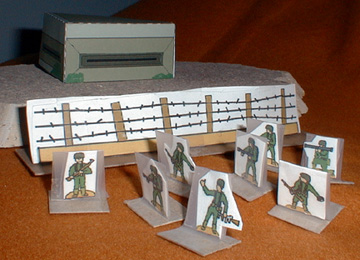
This is a revised version of a set of rules I wrote three years ago. The original version was published in The Volunteer. This new version is simpler, and the format is the same as the other scenarios on this web site.
Historical Background
On June 6, 1944, the liberation of France began. Americans, and their allies, launched a massive amphibous assault on the beaches of Normandy. The attack took the Germans by surprise. In some places the Allies faced light resistance. But on Omaha Beach the Americans faced a fearsome German defense consisting of concrete bunkers, mine, barbed wire, machine guns, and artillery. Despite the many obstacles in their path the Americans succeeded in breaching the defenses and forcing their way off the beach. The victory on "Bloody Omaha: was a big step towards winning the war in Europe.
Battle 1
The landing craft dropped their ramps and the Americans waded onto the beach, right into the teeth of the German defenses. It was hard going for the Americans, and most of the first wave were wiped out. As the second wave began landing a few small, disorganized groups of Americans crossed the sea wall and breached the wire and mines. Their attempts to assault the bunkers up on the bluffs were stopped by a tight concentration of artillery and merciless machine gun fire. The first break for the Americans came when a determined young lieutenant managed to lead nearly his entire assault crew across the beach. His men destroyed the bunker anchoring the end of the German line before his men were pinned down while attempting to attack the next bunker. Elsewhere on the beach other American commanders were taking the fight to the enemy. As "The Longest Day" ended the Americans destroyed a second bunker, securing the foothold on the beaches of Normandy they desperately needed. This battle was a narrow American victory.
Battle 2
This assault went very well. The Americans were able to make it across the beach with their formations mostly intact thanks to a miserable performance by the German artillery. The Americans quickly created several large breaches in the belt of mines and wire and went to work attacking the bunkers. The Germans counterattacked ferociously, but the Americans couldn't be stopped. Three German bunkers were destroyed in rapid succession. This battle was a decisive American victory.
Victory Conditions
The Americans must destroy at least two German bunkers to win a victory.
The Board
I made my beach out of sections of painted cardboard (blue paint for the water, textured paint - American Accents "Stone Creations" for the beach). The number of sections used depends on how many students are participating (the longest beach used so far was twelve feet). The board should consist of 6 or more inches of water, two feet of beach, a 4 inch section of obstacles, and at least four inches of ground for the German bunkers. Paint or use a marker to draw a line at the edge of the water and another line at the end of the 2 feet of beach directly in front of the Obstacles area to represent the Sea Wall. The Obstacles area should be divided into 6" wide segments. The Obstacles can be represented by a piece of picture wire wound in a spiral and glued to cardboard. Here are some paper barbed wire sections you can print and use: color wire, black & white wire. Each 6" segment of obstacles should have one or two lines of wire in it.
Building the Armies
There are many companies that produce 1/72 plastic figures for World War II (most of mine are Revell and Airfix. American figures should be based individually Here are some paper soldiers you can print and use: colored soldiers, black & white soldiers. The black & white soldiers can be reproduced on a copying machine (print opposing armies on different colored paper) or given to the kids to color. We took some plastic hardware trays and spray painted them gray to represent landing craft. Here are some paper landing craft you can print and use: landing craft black & white, landing craft color. You don't need any German figures to play this scenario, the Germans are represented by bunkers. Bunkers were created using cardboard topped with thin card stock. They were glued together with Elmer's Glue and a firing slit was cut using a razor utility blade. The insides were spray painted black. The outsides were sprayed using white spray paint and American Accents "Stone Creations" spray paint to add texture. A good alternative would be to spray paint the outside with grey. A door was painted on the back using Folk Art acrylic paints. The door is purely decorative and has no effect on game play. You can also use these paper bunkers: color bunker, black & white bunker.
Order of Battle
The Americans are grouped into assault squads of twelve men. The Germans have concrete machine gun bunkers. I use 3 American squads and two German bunkers per two foot section of beach. The German bunkers should be placed behind the obstacles and should be at least 8" apart.
Resources
Here are some useful resources for wargaming Omaha Beach:
D-Day by Stephen Ambrose includes some excellent sections on the Omaha landings
The beach landing scenes at the beginning of the film "Saving Private Ryan"
There are many good websites covering the Normandy Invasion, including: http://www.britannica.com/normandy/week2/Omaha_Beach.html
Get off the Beach D-Day Normandy Invasion
- Historical Background and Set Up
Fast Play Rules for Students
Paper Soldiers and D-Day (very slow: 282K)
Back to Table of Contents -- Junior General Report # 4
Back to Junior General Report List of Issues
Back to MagWeb.com Magazine List
© Copyright 2004 by Matt Fritz.
This article appears in MagWeb.com (Magazine Web) on the Internet World Wide Web. Other articles covering military history and related topics are available at http://www.magweb.com